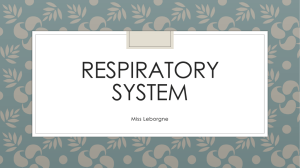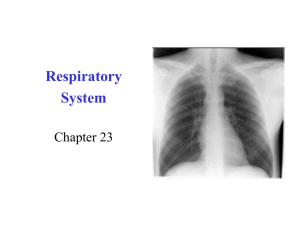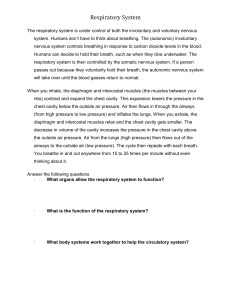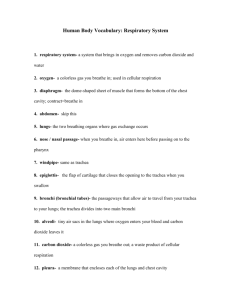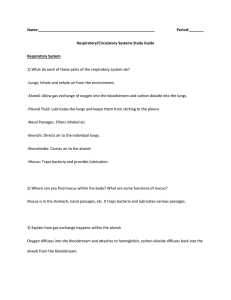Chapter 15 Respiration System Name Section 1 Date Period ____ A
advertisement
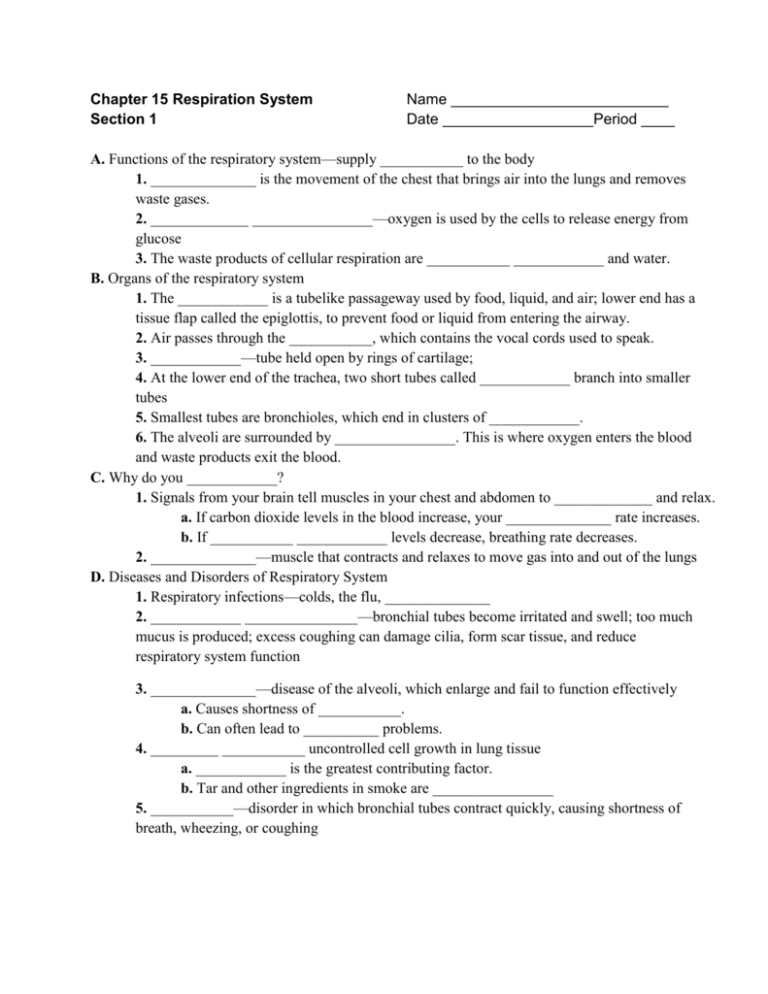
Chapter 15 Respiration System Section 1 Name __________________________ Date __________________Period ____ A. Functions of the respiratory system—supply ___________ to the body 1. ______________ is the movement of the chest that brings air into the lungs and removes waste gases. 2. _____________ ________________—oxygen is used by the cells to release energy from glucose 3. The waste products of cellular respiration are ___________ ____________ and water. B. Organs of the respiratory system 1. The ____________ is a tubelike passageway used by food, liquid, and air; lower end has a tissue flap called the epiglottis, to prevent food or liquid from entering the airway. 2. Air passes through the ___________, which contains the vocal cords used to speak. 3. ____________—tube held open by rings of cartilage; 4. At the lower end of the trachea, two short tubes called ____________ branch into smaller tubes 5. Smallest tubes are bronchioles, which end in clusters of ____________. 6. The alveoli are surrounded by ________________. This is where oxygen enters the blood and waste products exit the blood. C. Why do you ____________? 1. Signals from your brain tell muscles in your chest and abdomen to _____________ and relax. a. If carbon dioxide levels in the blood increase, your ______________ rate increases. b. If ___________ ____________ levels decrease, breathing rate decreases. 2. ______________—muscle that contracts and relaxes to move gas into and out of the lungs D. Diseases and Disorders of Respiratory System 1. Respiratory infections—colds, the flu, ______________ 2. ____________ _______________—bronchial tubes become irritated and swell; too much mucus is produced; excess coughing can damage cilia, form scar tissue, and reduce respiratory system function 3. ______________—disease of the alveoli, which enlarge and fail to function effectively a. Causes shortness of ___________. b. Can often lead to __________ problems. 4. _________ ___________ uncontrolled cell growth in lung tissue a. ____________ is the greatest contributing factor. b. Tar and other ingredients in smoke are ________________ 5. ___________—disorder in which bronchial tubes contract quickly, causing shortness of breath, wheezing, or coughing Directions: Label the parts of the respiratory system shown in the diagram below. Directions: In the space provided below, write the name of the structure indicated. _____________________________8. warms and moistens air; filters dust particles _____________________________9. transports air to the lungs ____________________________10. prevents food from entering the trachea ____________________________11. oxygen passes into the capillaries ____________________________12. organ made up of masses of alveoli ____________________________13. a sheet of muscle across the bottom of the chest cavity ____________________________14. a division of the trachea Directions: Label each statement below as a description of either inhalation or exhalation. Write the word inhale or exhale in the space provided below. ____________________________15. The diaphragm contracts. ____________________________16. Air pressure in the chest cavity increases. ____________________________17. The gases inside the lungs are pushed out through air passages. ____________________________18. Air pressure in the chest cavity decreases. ____________________________19. The volume of the chest cavity increases.
